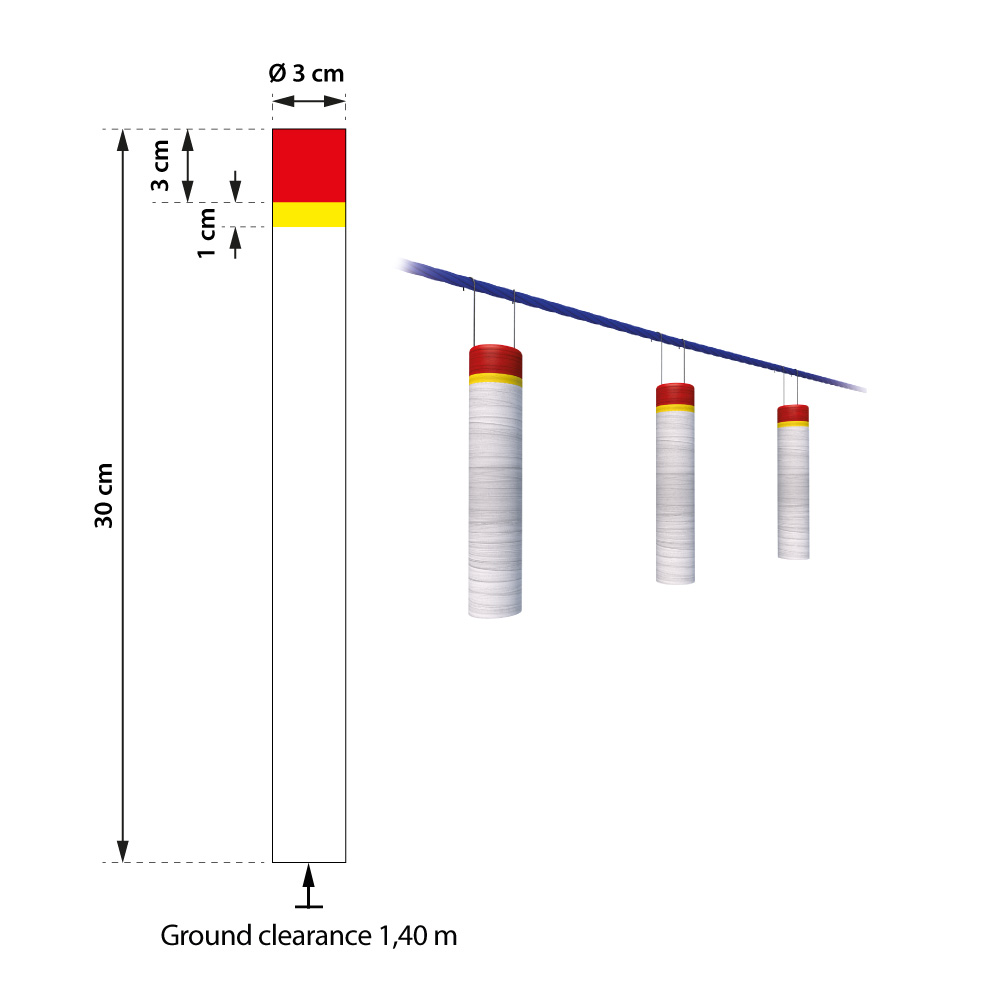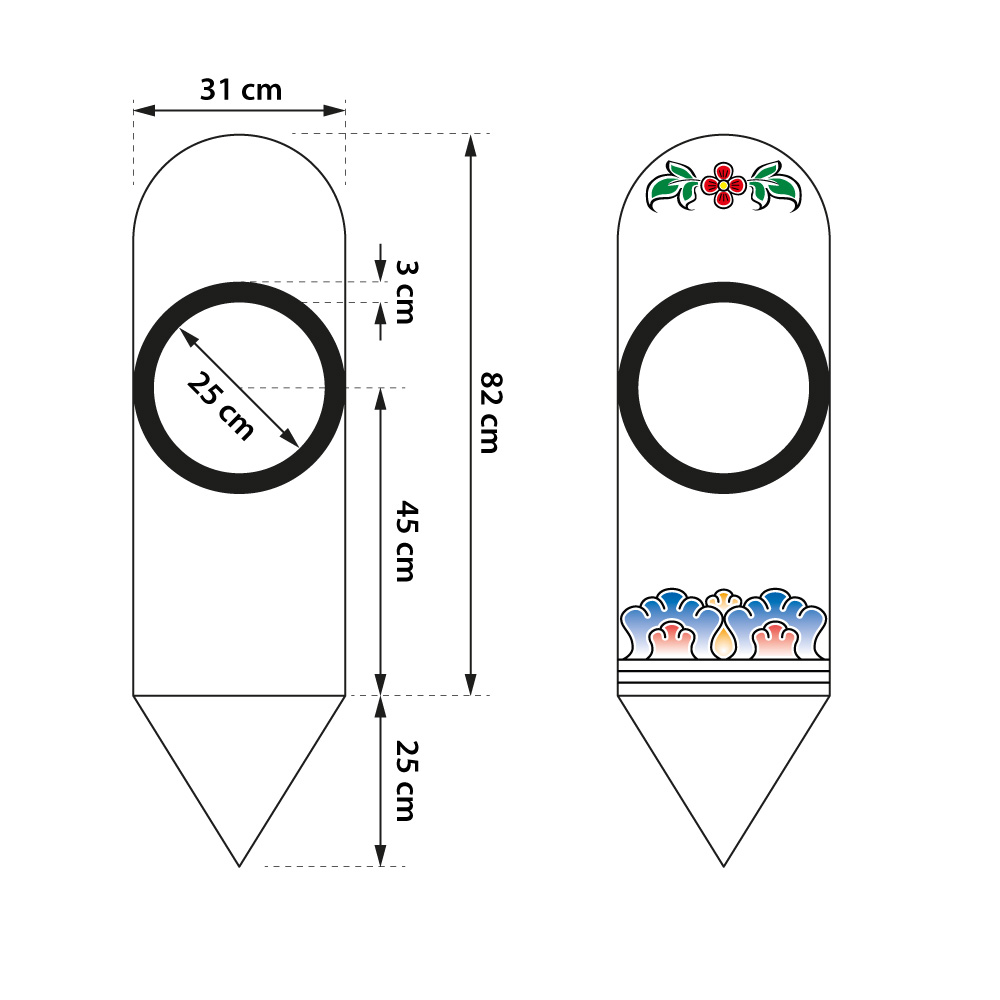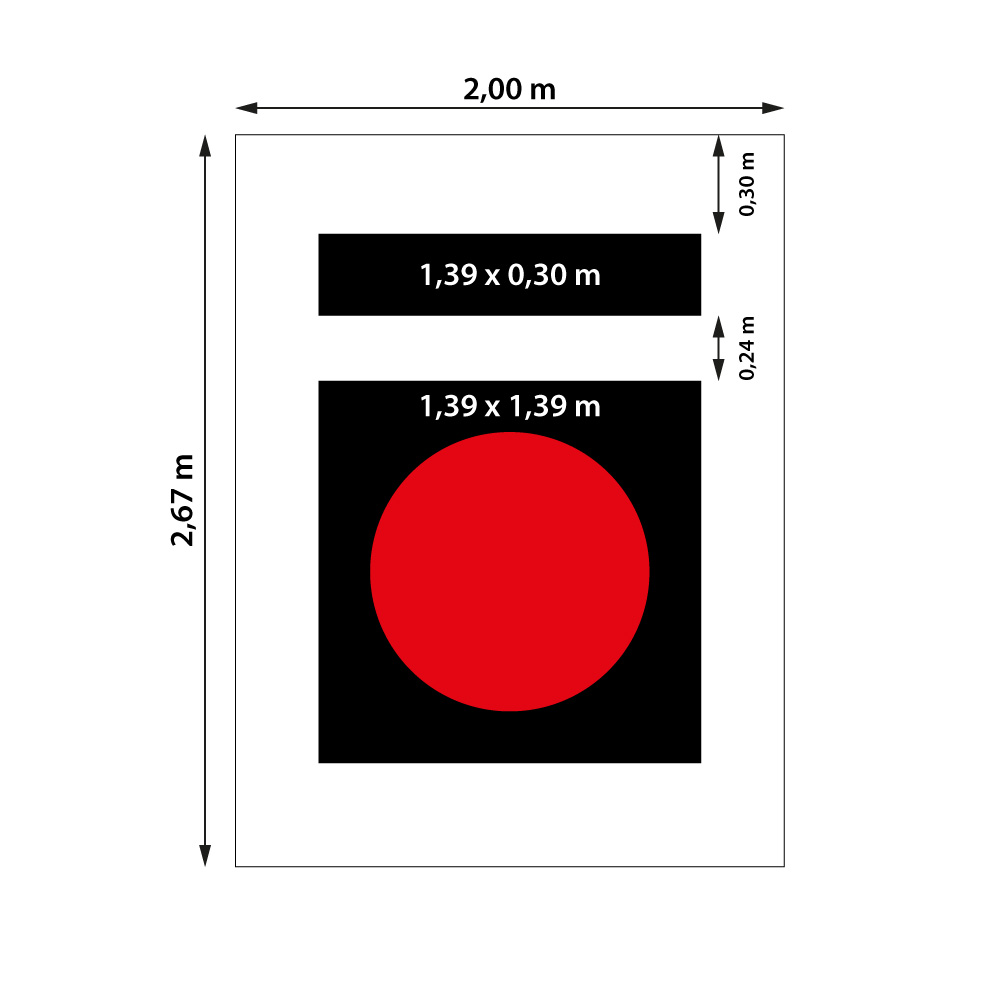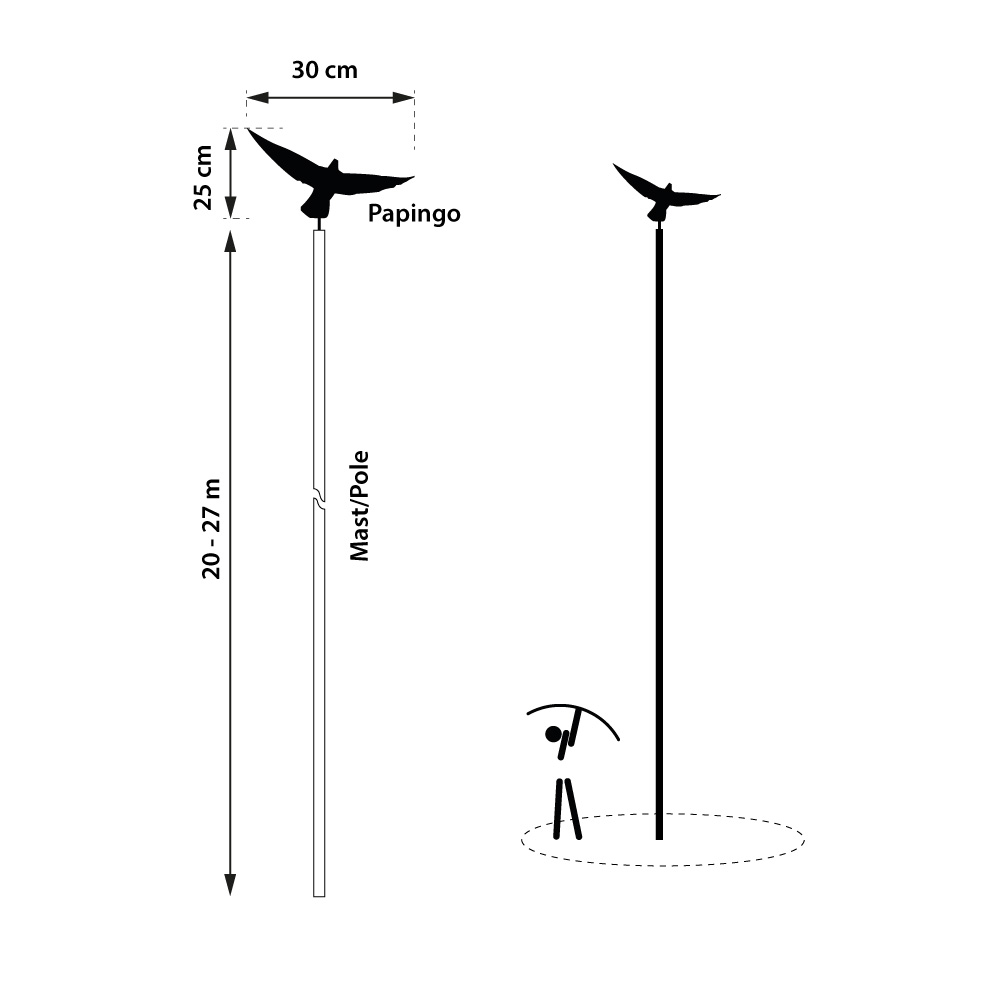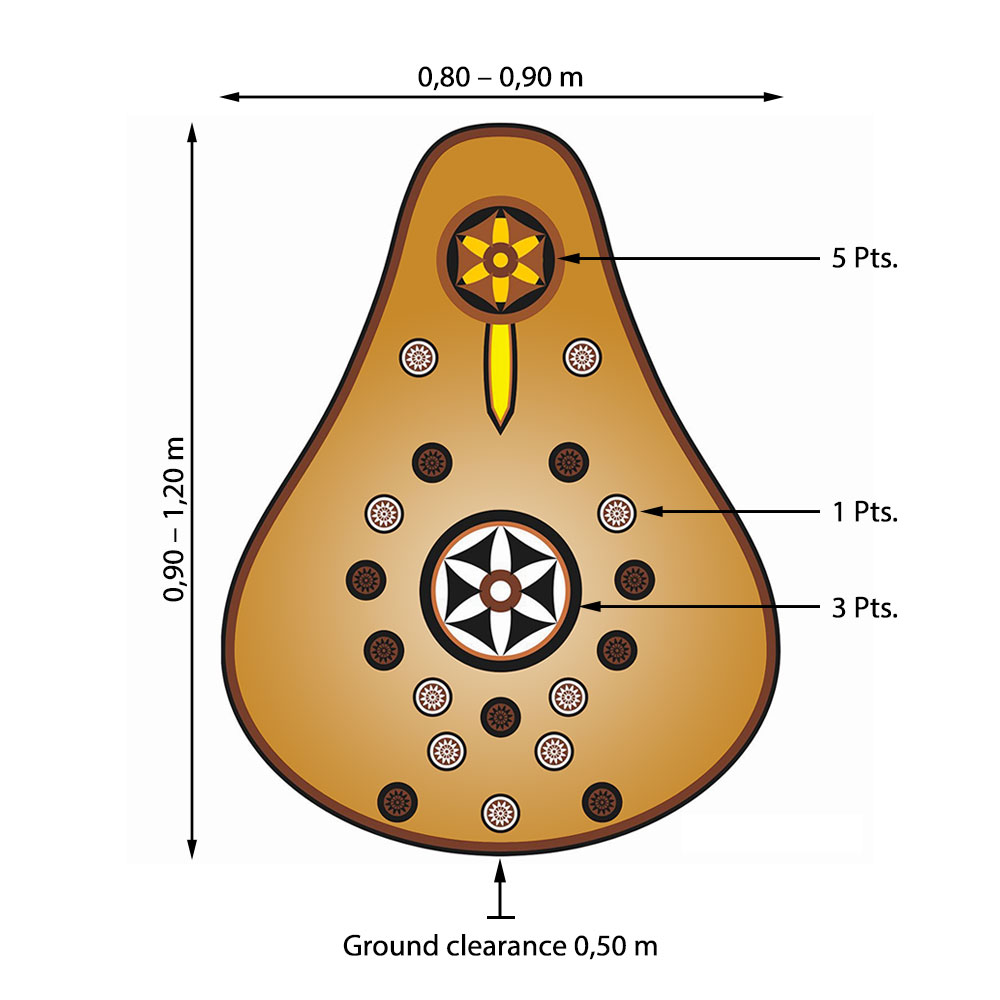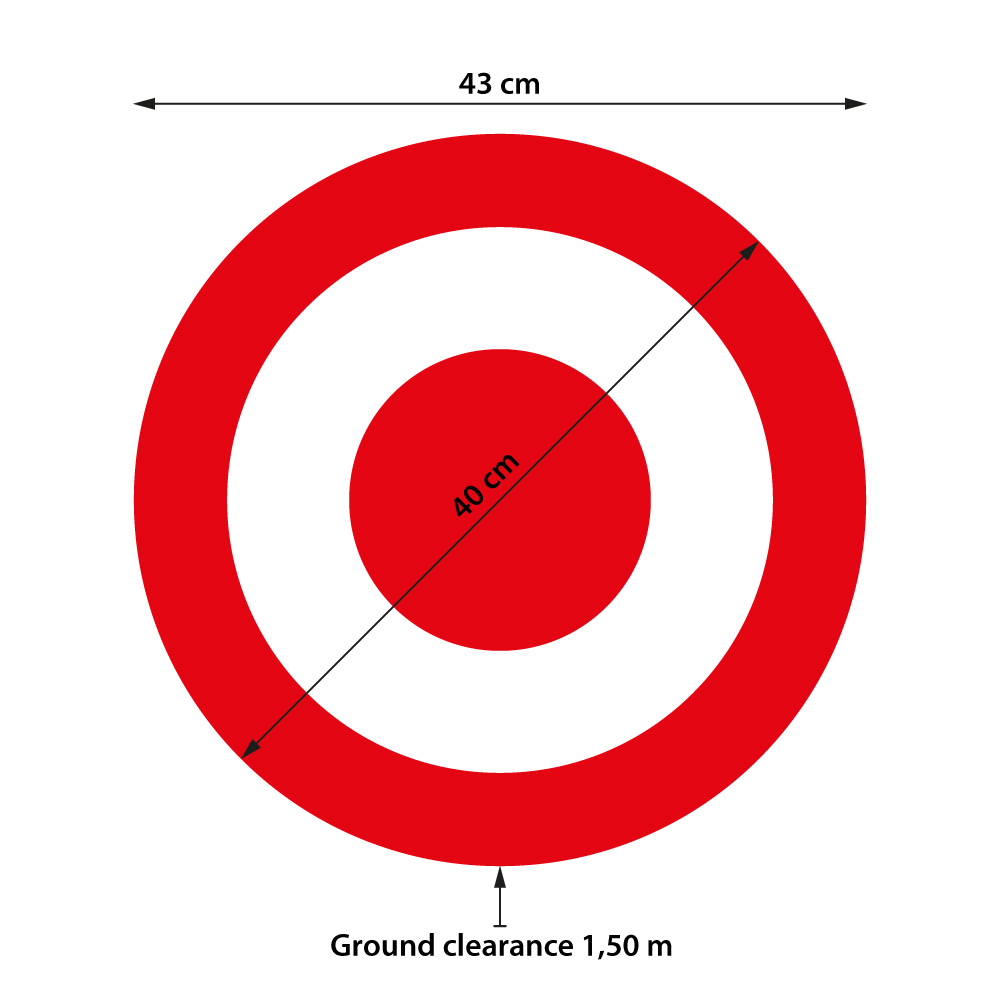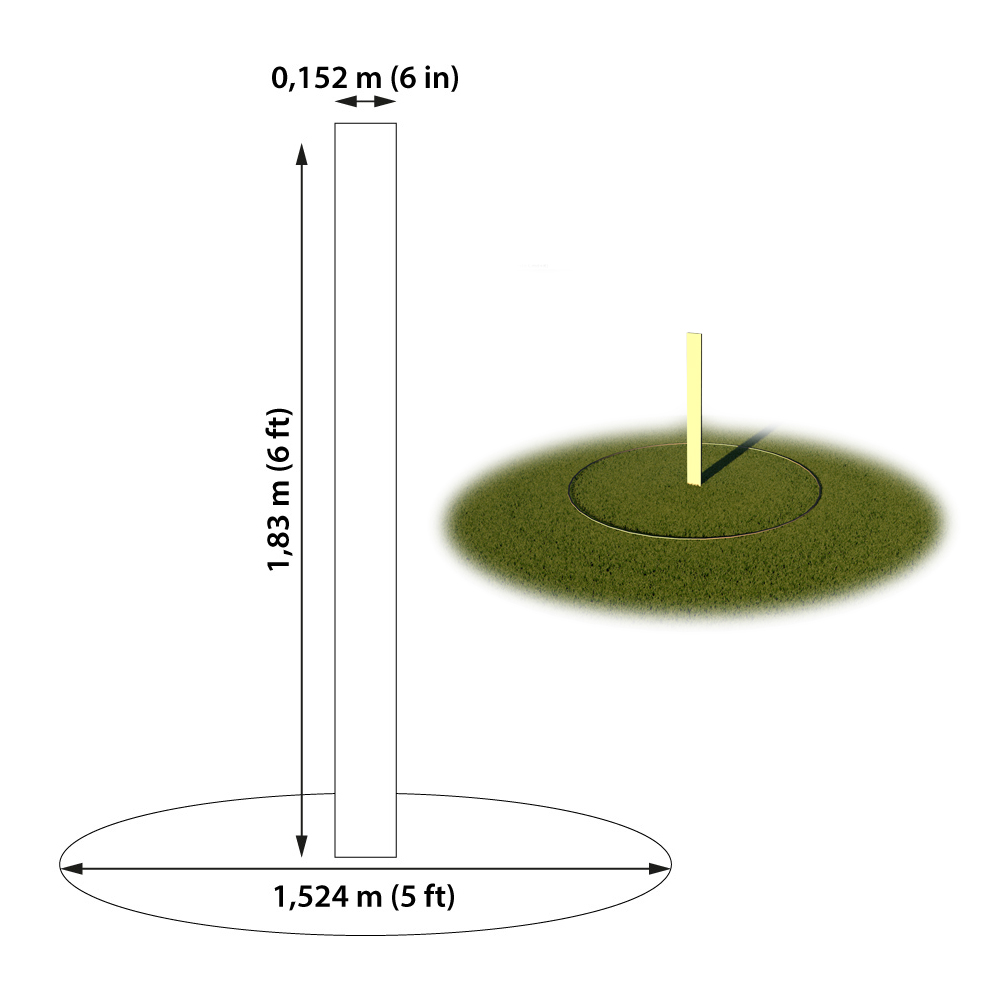. . .
Diameter: 3 cm
Height: 30 cm
Adaptation for T.A.I. Shooting Distance: 30 m 3 arrows are to shoot
Historical Background
The history of Jemparigan goes way back before the 17th century. In the years between 1755 till 1792 it was Sri Sultan Hamengku Buwono I, the first king of Yogyakarta, who encouraged his followers to learn archery as a means of forming the character of a knight. The character of the knight in question is the four values ordered by Sri Sultan Hamengku Buwono I to be used by the people of Yogyakarta, namely sawiji, greget, sengguh, and ora mingkuh.
“Sawiji” means concentration, “Greget” means enthusiasm, “Sengguh” means confidence, and “Ora Mingkuh” means having a sense of responsibility.
The target is called “Bandulan”, the lower section, known as the awak (body) is painted white, the top called “Sirah” (head). The yellow ring between head and body is called “Leher” (neck).
Initially, this game was only performed among the Mataram Kingdom family, and was made into a race among government soldiers. But over time, the art of archery is now increasingly popular and played by many people from among the common people.
Jemparingan is different from other archery which focuses on the archer’s ability to aim correctly at the target. Also, when archery is usually done standing up, Jemparingan is done cross-legged.
The archer does not aim with his eyes either, but positions the bow in front of his stomach so that the shot is directed according to the archer’s feeling. Nowadays archers are aiming at the target called „Bandulan“.
Width: 31 cm
Height: 82 cm
Adaptation for T.A.I.
Shooting Distance: 80 - 140 m
3 arrows are to shoot
Only one target
Historical Background:
In Butan traditional archery, there are at least two targets needed. The targets are placed at a ‘long distance’ with archers going back and forth between two targets. Traditionally they shoot one pair of arrows each way, with a bamboo bow.
The target is made of wood and shall preferably be blue pine. Knots of the timber should be removed and the holes so created stuffed with soft wood. A piece of strong white cotton cloth shall be pasted with glue to cover the entire surfaces of the target which will be the base for painting as well as for prevention of target from splitting with increasing number of Kareys or hits on the target. The painting on the target is usually of rainbow colours around the bull’s eye, water and 5-petal lotus pattern at the bottom. Other permissible patterns may be allowed. The Bulleye is called Gorthig. The targets are rounded off at the top and tapered to a point at the base, which is embedded in the ground. The shooting distance was and still is 140 m.
The shooting area is called „Bacho“ and should be 200 meters in length and 10 meter wide. Behind the area a 25 meter long area is recommended for safety reasons. The shooting area consists of the following: “Hopsi”, or the frames, decorated with colorful scarves and greenery. “Sirri” are called the lines left and right of the „Bacho“ which consist of saplings and flags „Dhar“. Two upright fine woods target with the traditional bull’s eye and surrounding rings. Safety-barricade are made of sandbags.
Origin: France
Diameter: 60,69 cm (2ft)
91,44 cm (3ft)
121,92 cm (4ft)
Adaptation for T.A.I. Shooting Distance: 40, 60, 80 m The bigger the diameter the longer the distance 5 arrows are to shoot
Historical background:
It is not know exactly, when the target face with the concentric rings were invented. Historically, archers shot at a mark on a butt and were scored in various ways, such as on whether you hit the butt, the mark or by seeing who’s arrows came closest to the mark. Targets with concentric rings may date back to 1400s. They existed in the mid 1700s, and by 1781 some archery contests were scored based on numeric values assigned to each ring, but were also judged on the number of hits to the target overall rather than the rings, a practice which continued through the 1800’s. Even today, many archery contests still record the total number of hits in addition to the ring-based numerical score. Also known is, by 1792, three sizes developed, 2, 3, and 4 feet in diameter. These were shot at distances of 60, 80 and 100 yards according to their sizes.
Width: 2,00 m
Height: 2,67 m
Adaptation for T.A.I.
Shooting distance 120 m
6 arrows are to shoot
Historical Background:
As I stated earlier, an archer will bow to the Jung Gahn when first arriving at the jung. Also, just before an archer makes a first shot, he/she will give a slight bow to the target saying “Hwal bae oom ni da,” which means, “I am learning the bow.” If other members are present, they would reply, “Ma ni ma chu sayo”, which means, “Have many hits.” A novice archer would also bow to the target after the first hit of the day, while advanced archers would not.
In 1899, the visiting Prince Heinrich of Prussia expressed his astonishment to Emperor Gojong at a traditional archery demonstration. The emperor, impressed, decreed “let people enjoy archery to develop their physical strength” and established an archery club building. In the subsequent revival of Korean archery, the nature of the bow and the arrow was standardized, as was the range of the targets. Korean traditional archery now uses one specific type of composite bow, bamboo arrows, and a standard target at a standard distance of 120 bo (about 145 meters).
Pole height: 20 – 27 m
Papingo Size: prox. 25 x 30 x 5 cm
Adaptation for T.A.I. Shooting distance: prox. 18 - 25 m Shooting position: 2 - 3 m away from the pole max. 3 Arrows to shoot
The archery form of popinjay dates back to at least the fifteenth century. The annual papingo (popinjay) tournament of the Ancient Society of Kilwinning Archers, of Ayrshire in Scotland, takes place at Kilwinning Abbey, with the “Papingo target” on the end of a pole projecting from the top of the tower. The event is believed to have been running since 1488, though the earliest records are attested in a minute of the society dated September 1688.
There were different ways to shoot a Popinjay: One Bird on a mast/pole or there was a set of birds on perches. The object of popinjay is to knock artificial birds off their perches. The perches are cross-pieces on top of a 90-foot (27 m) mast. The “cock” (the largest bird) is set on the top cross piece. Four smaller “hens” are set on the next crosspiece down. Two dozen or so “chicks” (the smallest birds) are set on the lower cross pieces. (according to the Grand National Archery Society UK (GNAS)
The archer stands near the base of the mast and shoots arrows upwards at the birds. The arrows are tipped with rubber blunts rather than sharp points. The blunts are between 0.75 inches (19 mm) and 1-inch (25 mm) in diameter.
Width: 0,77 – 0,90 m
Height: 107 – 1,20 m
Adaptation for T.A.I.
Shooting distance: 70 - 120 m
6 arrows to shoot
Historical background:
Traditional made of leather, the word “Puta” is ethymologically related to the Persian word “Bute” which means “Jug or Pot made of clay”.
Putas found their final form in the 18th century. They were 107 centimeters in height and 77 centimeters in width, and the depth of the puta was about 8 to 10 centimeters. A pear shaped, double layered leather pillow would be placed into a wooden or reed frame, also covered with leather. The pillow would be filled with cotton seed or saw dust. After these steps, shapes in different colours would be drawn on the puta. Finally little bells would be attached to the bottom of the puta. The bells would make a sound when the puta were hit, thus informing shooters. Seeing a hit could be difficult due long distances. Despite the lack of concrete historical evidence regarding the meaning of shapes and colors on putas, one could speculate that it might be a way to create several different targets on the same puta. The purpose of the little bells is obvious however; they were to inform the archers or the audience of hits, as described above.
Since its inception, several different rules emerged and applied to puta shooting. Puta shooting competitions were called “puta koşusu” (puta run). Puta shooting, while differing for every okmeydanı (archery range; there were several across the Ottoman Empire and the Middle East) was usually done from a distance of 250-400 gez (165-265 meters) and the shooting was done from a place called “sofa”.
Source: Murat Özveri, Tirendaz, Turkey -> detailed information
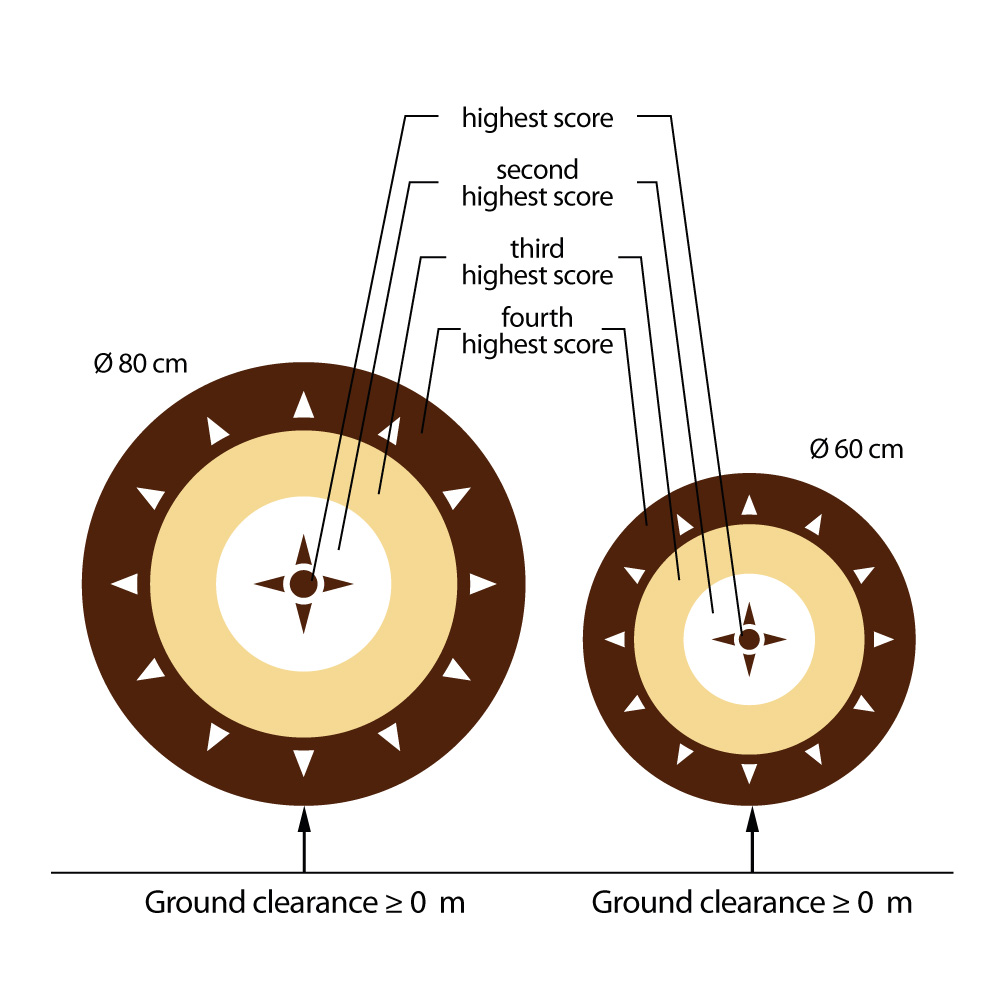 Origin: Mindanao, South Philippines
Origin: Mindanao, South Philippines
Big – Diameter: 80 cm
Small – Diameter: 60 cm
Adaptation for T.A.I.
Shooting Distance:
13 - 40 m on a 60cm face
40 - 65 m on a 80cm face
3 arrows standard round
6 arrows technical round
Historical Background
“Taming” is a Filipino and Malay term for war shields that is prevalently used in the Visayan and Mindanao regions of the Philippines and nearby South East Asian countries. Most surviving pieces are now in Museums and private collectors, they are large wooden or rattan circular shields (60cm-80cm in diameter & painted in bright colors often depicting the sun), They can cover a warrior from just above the knee upto this shoulder, roughly similar in size to the ancient Greek aspis or hoplon. Because of its size, they are also effective in defending against arrows, poison darts, and thrown spears before engaging in melee combat.
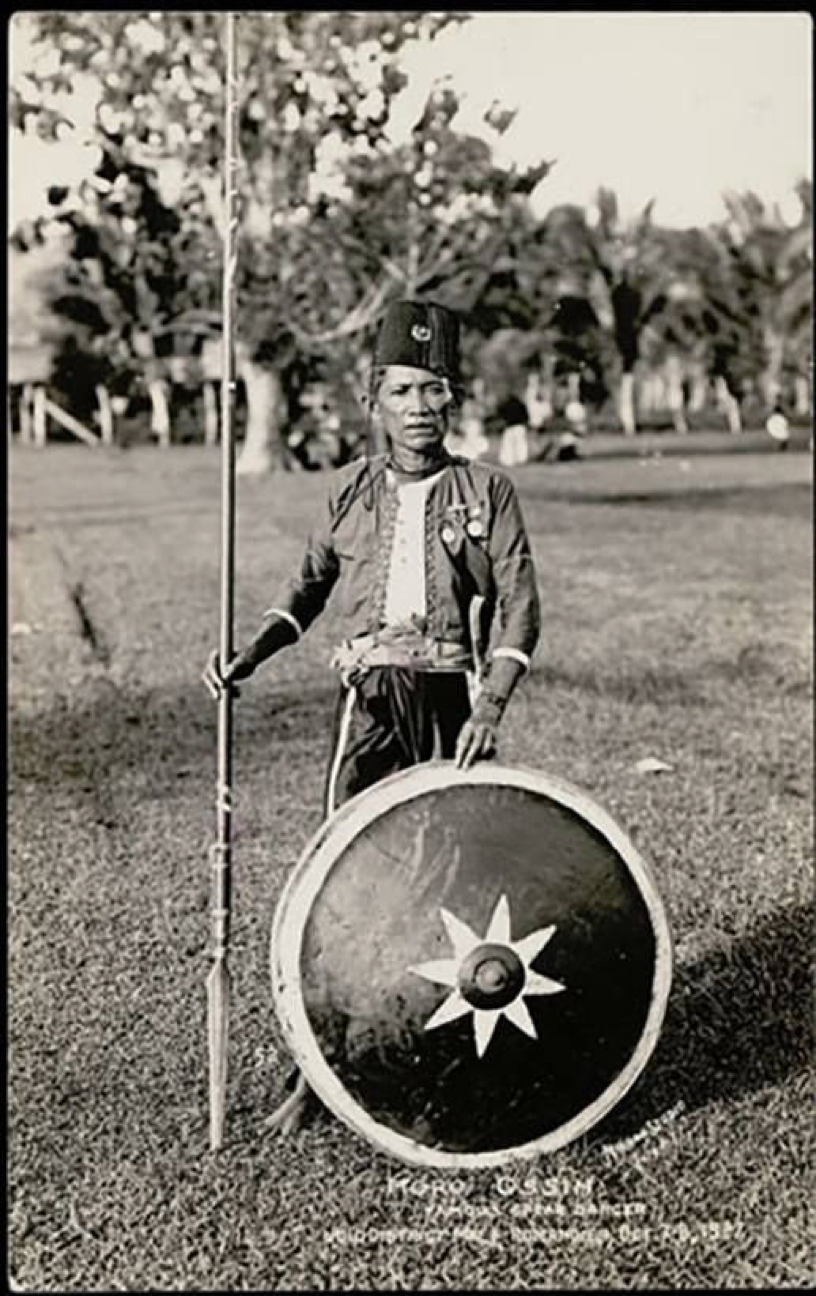 Taming target face was introduced by Historical Archers Philippines as one of two official traditional archery target faces. The colors are in traditional earth colors with 3 concentric score areas and a dot bulls-eye depicting the center of the sun. There are two ways to set up the Taming as a target, one is the center should be at chest level (depicting a standing warrior) or low on the ground depicting a stalking warrior or defending from a rain of arrows.
Taming target face was introduced by Historical Archers Philippines as one of two official traditional archery target faces. The colors are in traditional earth colors with 3 concentric score areas and a dot bulls-eye depicting the center of the sun. There are two ways to set up the Taming as a target, one is the center should be at chest level (depicting a standing warrior) or low on the ground depicting a stalking warrior or defending from a rain of arrows.
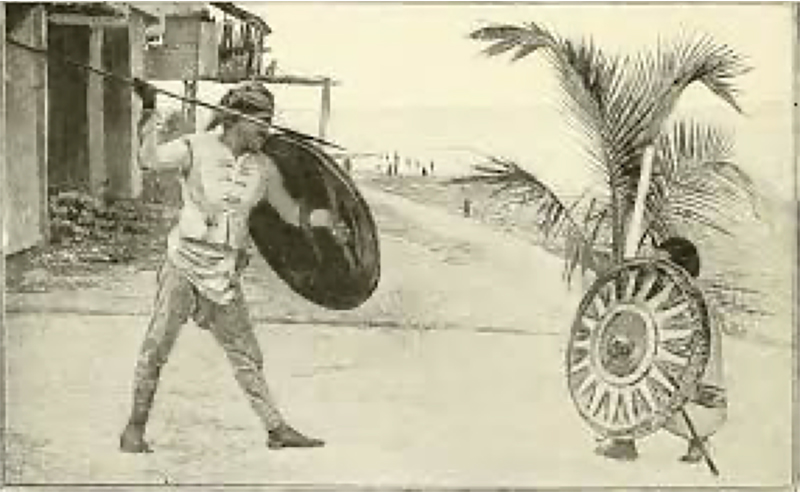 | 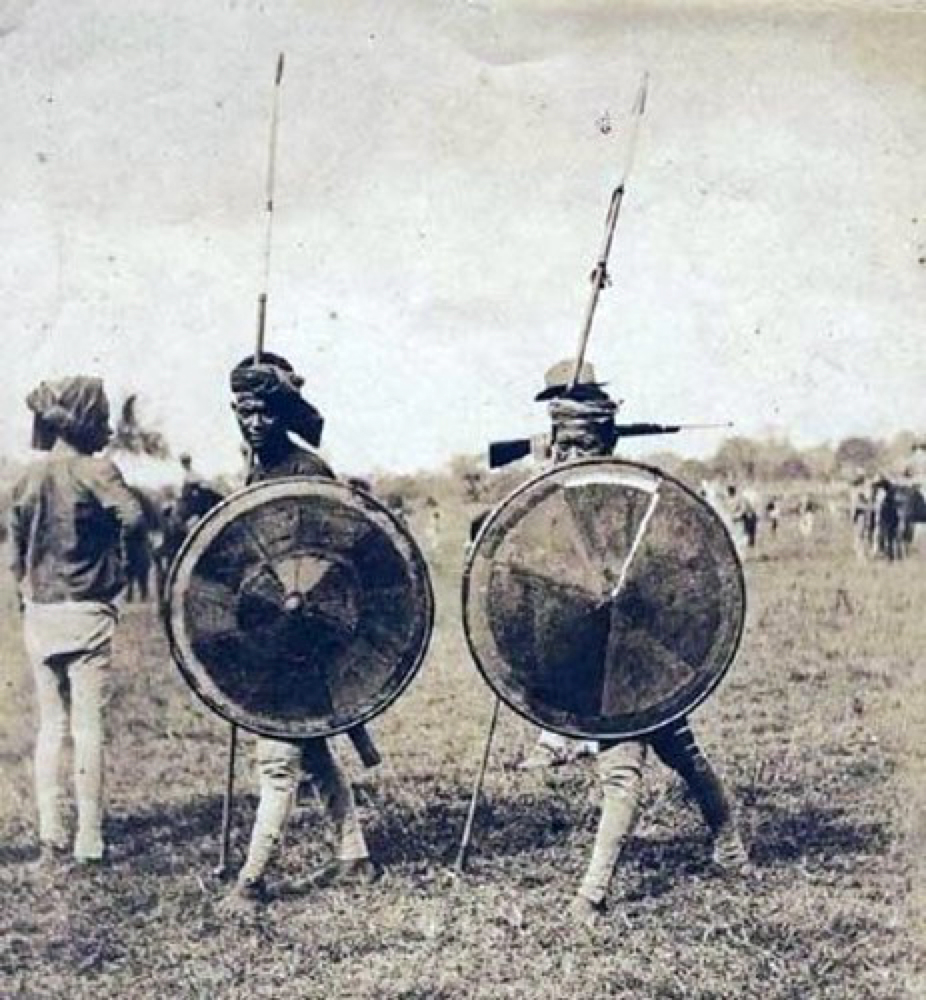 |
Source: Heinrich Lezama, Philippines
Diameter: 40 cm
Ground clearance: 1,50 m
Adaptation for T.A.I.
Shooting distance: is given
Children may shoot half distance
3 arrows per Target are to shoot
3 targets to shoot - 1st: standing frontal, 2nd: kneeling,
3rd: standing with the back to the targets
Usually there are 3 sets of these targets in a given distance.. The archer shoots each target from 3 different positions (Standing frontally, kneeling and facing with your back). The archer shoots 5 arrows from each position. This shooting will be done 2 times (2 rounds = 90 arrows to be shot). All competitions are shot in a given order in one sequence without breaks or checking or training. The maximum number of points to be scored will be 900 points for the scoring 10/8/5 point (inner to outer ring) The archery target with a common three-zone layout, with specially enlarged central zone that favors shooting and sub-missionary archers (means instinctive archers) by increasing the chance of getting the maximum score, even with a larger spread of hits.
Source: Karol Pisarkiewicz, PSŁT, Poland
Width: 15,2 cm
Height: 183 cm
Adaptation for T.A.I.
Shooting distance: 30 - 100 m
6 Arrows are to shoot
Historical Background:
In England archers startet to practice at seven years of age and were expected to hit the Mark with the use of a War Bow at 220 yards, by the time they were 15 years of age. To achieve this you set up the wand at a short distance first, as your Archers got the hang of hitting it regularly, you then moved the wand outor increased the distance, usually by ten yards at a time until your archers by age and skill could hit the wand or mark at 220 yards or (Artillery shot) battle shot. The ancient word for Archery is “Artillerie”.
The willow ‘wand’ represented an enemy of course, but would be much harder to hit being so narrow, especially with an English Longbow. Competitive Wand Shoots are very rare these days, but in the area of Surrey, archers still shoot this competition. 100 yards for the Gents, 80 yards for the Ladies, and 60 yards for the juniors 60 yard is the shooting distance. The ‘wand’ is set in a ground circle with a diameter of 5 ft. A ‘wand’ hit scores 5 points and a hit in the circle still makes 1 point. There are also other competitions held by AOTT (Archers of the Tees) where you shoot from in a given order from different distances.
